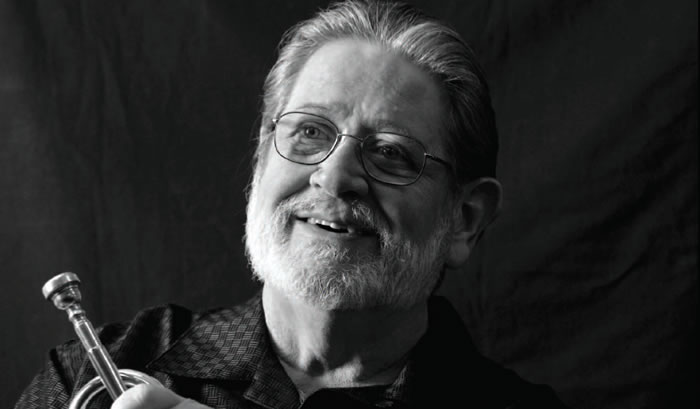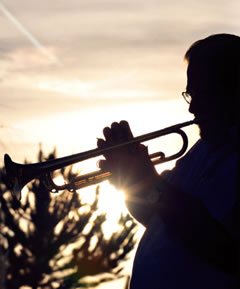


TRUMPETER BOBBY SHEW’S RESUME IS LONG AND COLORFUL. He played big-band jazz with Buddy Rich, Woody Herman, and the Tommy Dorsey Orchestra. He led blazing horn sections behind Elvis Presley, Tom Jones, Barbra Streisand, and Smokey Robinson. He performed on countless film and TV soundtracks and has garnered GRAMMY® nods for his recordings as a leader. And as a leading educator and instrument designer, he influences the lives of countless young players, even from his current semi-retirement near Albuquerque, New Mexico, not far from where he grew up.
“I’ve thought about stopping playing,” says Shew, “but that just doesn’t work for me. I don’t travel quite as much as I used to—too many knee implants, metal screws, and plates! But my passion in life remains music.” He chuckles. “And my wife.”

Musical passion came early for Bobby. By his early teens, he was gigging steadily with New Mexico dance bands. He honed his chops in the famed NORAD multi-service band. Other big-band gigs followed, including one with jazz drumming giant Buddy Rich.
“Playing with Buddy was one of the greatest things that ever happened to me,” says Shew. “I needed someone to push me, because I was a shy kid with a lot of insecurities. Buddy didn’t just push me into the lead trumpet chair—he threw me in, and then horsewhipped my butt! I told him I didn’t know if I had the chops. He said, ‘Don’t give me that crybaby crap! Go home, get your chops together, and then come in tomorrow and play lead!’ So I just pulled up my bootstraps, put on my seatbelt, and went for it.”
Shew soon evolved into a great lead trumpeter. His new skills led him to Las Vegas, where he played with many leading pop performers, including Elvis Presley during his famed 1968 comeback.
“We’d just backed Barbra Streisand for four weeks at the new International Hilton,” Bobby remembers. “Then Elvis came in. They’d made big-band arrangements of all his tunes, but the horns scared the hell out Elvis! I don’t think he’d ever heard a big band before. At first it was too loud and too confusing for him. But before long, he loved it.” During that run, the big band joined Elvis in the studio to cut some of the greatest tracks of the singer’s later career, including “In the Ghetto,” “Falling In Love,” and “Memories.”
In 1972 Bobby relocated to Los Angeles, seeking opportunities to expand as a jazz soloist. He played in small combos with Art Pepper, Horace Silver, and Bud Shank, and in big bands with Louie Bellson, Maynard Ferguson, Benny Goodman, and Toshiko Akiyoshi & Lew Tabackin. Meanwhile, he worked incessantly in the studios, contributing to many ’70s and ’80s movie and TV soundtracks.
Shew also became increasingly interested in music education. “If they remember me for anything,” he says, “it’ll probably be more for my educational work than my playing. I had some horrible education experiences as a kid, largely because there was a lot of negativity about jazz in the schools. That ignited a fire in me, a belief that the music I loved so much should be encouraged.”
I own 83 horns, including some very rare and collectible instruments, but none of them play anywhere near as well as my Yamahas.
Shew has conducted hundreds of clinics worldwide. He summarizes his teaching philosophy in three words: “Passion, inspiration, and motivation. A teacher must have a tremendous amount of passion for what he does. The student gets inspiration from that. He looks at the teacher and thinks, ‘Wow, this guy really loves what he’s doing. This music must be really great.’ And then the student has motivation. You don’t have to tell him to practice. He’s trying to attain something he recognizes in his teacher.”
Bobby also influences young players through the instrument he created with Yamaha, the YTR-8310Z trumpet. “It’s just an incredible instrument,” he says. “I own 83 horns, including some very rare and collectible instruments, but none of them play anywhere near as well as my Yamahas. The 8310Z was designed for maximum efficiency, because I don’t believe players should have to bust their butts just to play an instrument.”
The prototype 8310Z remains Bobby’s primary gigging instrument. Meanwhile, the model has become the horn of choice for aspiring trumpeters worldwide. “I go to lots of colleges, universities, and high schools, and it’s amazing how many players have this horn,” he says. “I was recently in Japan playing with these university bands, and if I looked up at the trumpet section, three out of five players would have my horn. I tell you, seeing that gives me a great feeling!”
(Photography Credit: Rob Shanahan)
























